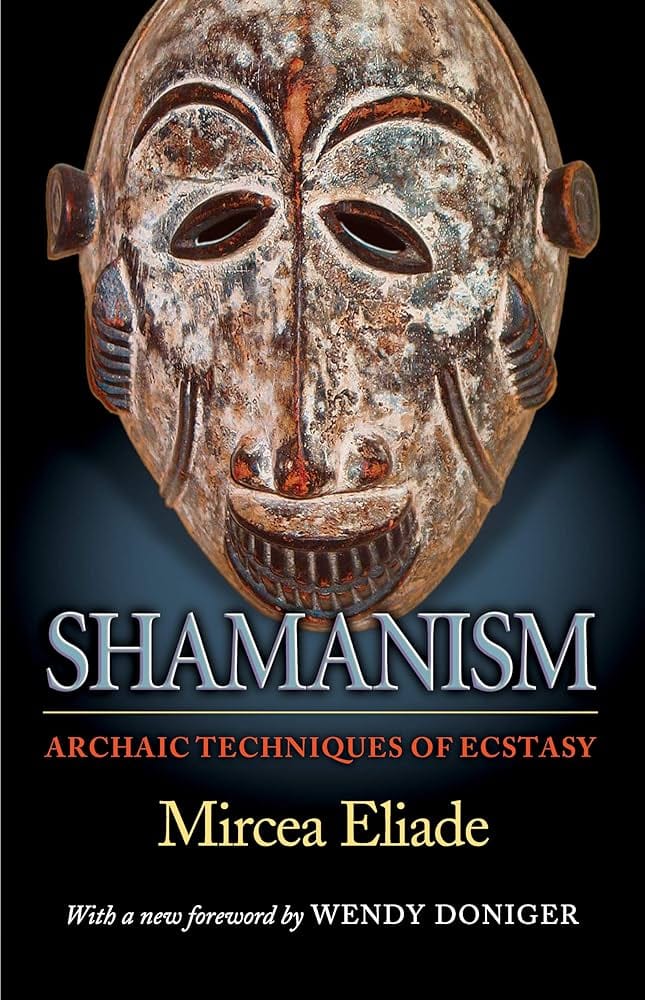Shamanism: Archaic Techniques of Ecstasy

Mircea Eliade’s Shamanism: Archaic Techniques of Ecstasy is like this dense, brainy, anthropological dive into shamanism that doesn’t hold your hand—it punches you straight in the face with information. Eliade’s not just some armchair academic; this Romanian cat traces shamanism across the globe, from the freezing Siberian tundra to the wilds of South America, with stops in India and Oceania. He’s got this vibe where he’s pointing out that, yeah, shamanism is different depending on where you’re at, but deep down, it’s all kinda the same at its core.
Now, Eliade kicks things off by defining what a shaman is—because you’ve got your medicine men, magicians, and your run-of-the-mill spiritual gurus, but nope, a shaman’s a different breed. These guys specialize in trance states where their souls ditch their bodies and take off—either soaring up to the heavens or diving into the underworld. It’s this cosmic road trip, and the shaman’s the only one with a passport to both places. Eliade’s all about how the shaman is the specialist in human souls. He’s the soul mechanic, man, tuning up what the rest of us can’t even see.
One of Eliade’s big ideas is the initiation process that shamans go through. You don’t just wake up one day and say, “Hey, I’m a shaman now!” No, no, no—you’ve gotta go through hell first, metaphorically (sometimes literally), with symbolic death and resurrection. It’s all about suffering, visions, maybe a near-death experience or two. Once you come out the other side, you’re not just a dude anymore—you’re a “technician of the sacred.” Think of it like the ultimate spiritual boot camp that kicks your ass, but you come out the other side with some serious mojo. Eliade lays out how this death-and-rebirth trip is a universal theme—you see it in every corner of the world where shamans are doing their thing.
Now let’s talk about the shaman’s toolkit. This ain’t just costumes and drums for show. Eliade goes deep on how a shaman’s outfit is packed with symbolism, and that drum? It’s not just making noise—it’s basically a cosmic spaceship, taking the shaman straight to the "center of the world" where the cosmic tree is. The cosmic tree’s a big deal, by the way. It’s a sacred symbol that shows up in a bunch of traditions, and the shaman’s got a front-row seat to it, using the drum like a jet engine to get there.
Then there’s the whole animal connection thing. Shamans don’t just hang out with spirit animals; these creatures are practically their alter egos. The shaman’s like, "Yeah, I can talk to wolves or fly like an eagle, no big deal." And these animals aren’t just buddies—they’re a bridge, allowing the shaman to transcend the regular human condition and tap into something way bigger, way older.
Eliade’s not done yet. He digs into the cosmology of shamanism—the idea that these guys are masters of traveling between different planes of existence. Earth, sky, underworld, doesn’t matter. A shaman can cruise through these realms like he’s taking a stroll down the block. Eliade’s convinced that when a shaman goes into ecstasy, they’re really going somewhere, and he’s all in on this mystical experience stuff. He also compares shamanism to secret societies and even gets into the psychology of it, talking about how these ecstatic journeys mess with the mind in a way that gives you serious insight into human consciousness.
Eliade breaks down how a shaman’s cosmic travels are at the heart of what they do—moving from one world to the next. He’s all about the symbolism. Horses and dogs get special shoutouts. The horse, for instance, is like a magic flying carpet, helping the shaman take off into the skies, and it’s tied to ecstatic dance—something Eliade loves to dig into. He’s obsessed with how these symbols cross cultures and yet somehow mean the same thing.
What keeps this book from being just another dry academic tome is Eliade’s use of real-world examples, especially from Siberian shamans. The guy loves Siberia. It’s like his spiritual home away from home. His main argument, though, is that shamanism is all about stepping outside the human condition. It’s a return to this mythical, pre-fall paradise where humans could talk to animals, understand the cosmos, and live without the burden of mortality. By guiding their communities through death and back, shamans give people some peace of mind about the whole “big unknown” waiting for everyone.
But Eliade’s book isn’t without its headaches. This thing is thick—like you’re gonna need some serious stamina to get through it. And let’s be real, it’s heavy academic stuff. You’ve gotta be into anthropology to truly appreciate it. Even though Eliade does a good job drawing connections between shamanic practices across the world, sometimes he can get a bit elitist.
Still, despite its quirks, Shamanism is a heavy-hitting piece of work. Eliade knows his stuff, and his meticulous research into the rituals, symbols, and beliefs of shamans worldwide makes this book a cornerstone in the study of religious history. If you’re into understanding what makes shamans tick, or you’ve got a thing for spiritual journeys that stretch across the globe, this book is gonna deliver. Just be prepared to wade through some dense passages to get to the juicy bits.
So yeah, in the end, Eliade’s got the goods. Shamanism is a deep-dive into one of the oldest spiritual practices on the planet, and whether you love the academic grind or you’re just fascinated by the idea of people traveling to other worlds in a trance, this book has something for you. It’s like a cosmic road map that shamans have been following for centuries, and Eliade’s here to decode the hell out of it for you.





